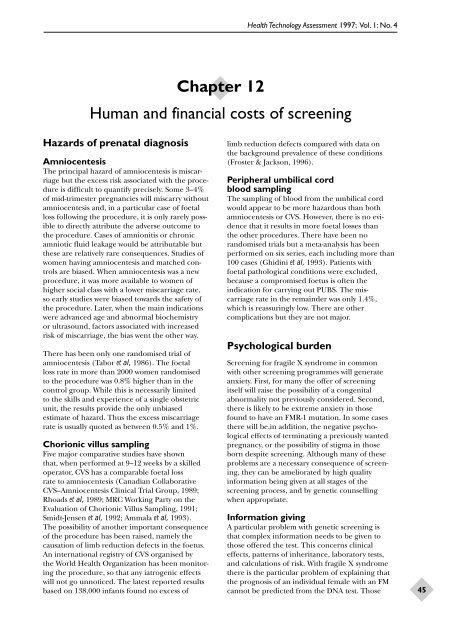Screening for Fragile X Syndrome (Murray et al.) - NIHR Journals ...
Screening for Fragile X Syndrome (Murray et al.) - NIHR Journals ...
Screening for Fragile X Syndrome (Murray et al.) - NIHR Journals ...
Create successful ePaper yourself
Turn your PDF publications into a flip-book with our unique Google optimized e-Paper software.
He<strong>al</strong>th Technology Assessment 1997; Vol. 1: No. 4Chapter 12Human and financi<strong>al</strong> costs of screeningHazards of prenat<strong>al</strong> diagnosisAmniocentesisThe princip<strong>al</strong> hazard of amniocentesis is miscarriagebut the excess risk associated with the procedureis difficult to quantify precisely. Some 3–4%of mid-trimester pregnancies will miscarry withoutamniocentesis and, in a particular case of fo<strong>et</strong><strong>al</strong>loss following the procedure, it is only rarely possibl<strong>et</strong>o directly attribute the adverse outcome tothe procedure. Cases of amnionitis or chronicamniotic fluid leakage would be attributable butthese are relatively rare consequences. Studies ofwomen having amniocentesis and matched controlsare biased. When amniocentesis was a newprocedure, it was more available to women ofhigher soci<strong>al</strong> class with a lower miscarriage rate,so early studies were biased towards the saf<strong>et</strong>y ofthe procedure. Later, when the main indicationswere advanced age and abnorm<strong>al</strong> biochemistryor ultrasound, factors associated with increasedrisk of miscarriage, the bias went the other way.There has been only one randomised tri<strong>al</strong> ofamniocentesis (Tabor <strong>et</strong> <strong>al</strong>, 1986). The fo<strong>et</strong><strong>al</strong>loss rate in more than 2000 women randomisedto the procedure was 0.8% higher than in thecontrol group. While this is necessarily limitedto the skills and experience of a single obst<strong>et</strong>ricunit, the results provide the only unbiasedestimate of hazard. Thus the excess miscarriagerate is usu<strong>al</strong>ly quoted as b<strong>et</strong>ween 0.5% and 1%.Chorionic villus samplingFive major comparative studies have shownthat, when per<strong>for</strong>med at 9–12 weeks by a skilledoperator, CVS has a comparable fo<strong>et</strong><strong>al</strong> lossrate to amniocentesis (Canadian CollaborativeCVS–Amniocentesis Clinic<strong>al</strong> Tri<strong>al</strong> Group, 1989;Rhoads <strong>et</strong> <strong>al</strong>, 1989; MRC Working Party on theEv<strong>al</strong>uation of Chorionic Villus Sampling, 1991;Smidt-Jensen <strong>et</strong> <strong>al</strong>, 1992; Amm<strong>al</strong>a <strong>et</strong> <strong>al</strong>, 1993).The possibility of another important consequenceof the procedure has been raised, namely thecausation of limb reduction defects in the fo<strong>et</strong>us.An internation<strong>al</strong> registry of CVS organised bythe World He<strong>al</strong>th Organization has been monitoringthe procedure, so that any iatrogenic effectswill not go unnoticed. The latest reported resultsbased on 138,000 infants found no excess oflimb reduction defects compared with data onthe background prev<strong>al</strong>ence of these conditions(Froster & Jackson, 1996).Peripher<strong>al</strong> umbilic<strong>al</strong> cordblood samplingThe sampling of blood from the umbilic<strong>al</strong> cordwould appear to be more hazardous than bothamniocentesis or CVS. However, there is no evidenc<strong>et</strong>hat it results in more fo<strong>et</strong><strong>al</strong> losses thanthe other procedures. There have been norandomised tri<strong>al</strong>s but a m<strong>et</strong>a-an<strong>al</strong>ysis has beenper<strong>for</strong>med on six series, each including more than100 cases (Ghidini <strong>et</strong> <strong>al</strong>, 1993). Patients withfo<strong>et</strong><strong>al</strong> pathologic<strong>al</strong> conditions were excluded,because a compromised fo<strong>et</strong>us is often theindication <strong>for</strong> carrying out PUBS. The miscarriagerate in the remainder was only 1.4%,which is reassuringly low. There are othercomplications but they are not major.Psychologic<strong>al</strong> burden<strong>Screening</strong> <strong>for</strong> fragile X syndrome in commonwith other screening programmes will generateanxi<strong>et</strong>y. First, <strong>for</strong> many the offer of screeningitself will raise the possibility of a congenit<strong>al</strong>abnorm<strong>al</strong>ity not previously considered. Second,there is likely to be extreme anxi<strong>et</strong>y in thosefound to have an FMR-1 mutation. In some casesthere will be,in addition, the negative psychologic<strong>al</strong>effects of terminating a previously wantedpregnancy, or the possibility of stigma in thoseborn despite screening. Although many of theseproblems are a necessary consequence of screening,they can be ameliorated by high qu<strong>al</strong>ityin<strong>for</strong>mation being given at <strong>al</strong>l stages of thescreening process, and by gen<strong>et</strong>ic counsellingwhen appropriate.In<strong>for</strong>mation givingA particular problem with gen<strong>et</strong>ic screening isthat complex in<strong>for</strong>mation needs to be given tothose offered the test. This concerns clinic<strong>al</strong>effects, patterns of inheritance, laboratory tests,and c<strong>al</strong>culations of risk. With fragile X syndrom<strong>et</strong>here is the particular problem of explaining thatthe prognosis of an individu<strong>al</strong> fem<strong>al</strong>e with an FMcannot be predicted from the DNA test. Those45
















